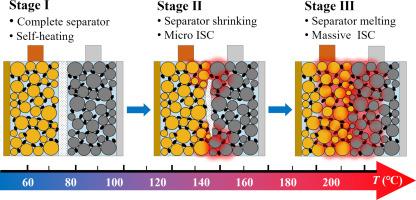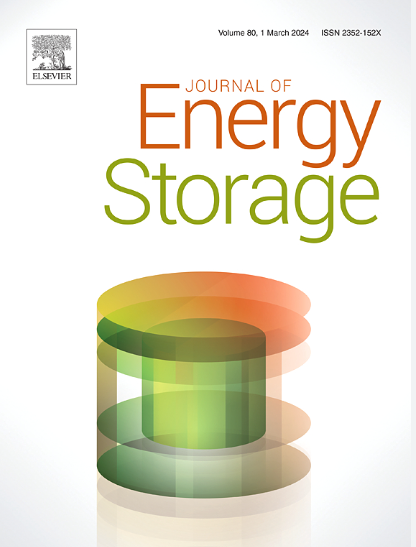从隔膜收缩特性角度看锂离子电池热失控的建模方法
IF 8.9
2区 工程技术
Q1 ENERGY & FUELS
引用次数: 0
摘要
热失控(TR)引发的安全问题是锂离子电池(LIB)大规模商业化的主要障碍。从本质上讲,热失控是一个电热耦合过程,涉及内部短路(ISC)和放热反应之间的相互作用。然而,大多数现有模型主要关注放热分解反应和 TR 期间的温度预测,而忽略了从机理角度对 ISC 行为的建模。本文提出了一种新型建模方法,通过隔膜收缩程度来定义电池的 ISC 状态。首先,对隔膜进行差示扫描量热计 (DSC) 实验,以确定其热收缩特性。然后,构建收缩函数,定量描述隔膜的热收缩情况。随后,作为分离器收缩程度函数的 ISC 传导率被整合到电热耦合模型中。因此,该模型可以定量评估分离器收缩或熔化导致的 ISC 行为。该模型在电压和温度预测方面的平均相对误差分别为 0.57 % 和 1.8 %。这表明该模型能够准确捕捉锂电池的电热耦合特性和 ISC 状态。这项工作为 TR 的机理研究和基于模型的 TR 警告提供了一个新的视角。本文章由计算机程序翻译,如有差异,请以英文原文为准。

A modeling approach for lithium-ion battery thermal runaway from the perspective of separator shrinkage characteristics
The safety concerns triggered by thermal runaway (TR) are the major obstacle to the large-scale commercialization of lithium-ion batteries (LIBs). In essence, TR is an electrical-thermal coupling process involving the interaction between internal short circuits (ISC) and exothermic reactions. Nevertheless, most existing models primarily focus on exothermic decomposition reactions and temperature prediction during TR, while overlooking the modeling of ISC behavior from a mechanistic perspective. This paper proposes a novel modeling approach that defines the ISC state of the battery through the degree of separator shrinkage. Firstly, differential scanning calorimeter (DSC) experiments are performed on the separator to ascertain its thermal shrinkage characteristics. Following this, a shrinkage function is constructed to quantitatively describe the thermal shrinkage of the separator. Subsequently, the ISC conductivity as a function of separator shrinkage degree is integrated into the electrical-thermal coupling model. Consequently, the model can quantitatively assess ISC behavior resulting from separator shrinkage or melting. The average relative error of the model for voltage and temperature prediction is 0.57 % and 1.8 %, respectively. This indicates that the model can accurately capture the electrical-thermal coupling characteristics and ISC state of LIBs. This work presents a novel perspective on the mechanism research of TR and model-based TR warning.
求助全文
通过发布文献求助,成功后即可免费获取论文全文。
去求助
来源期刊

Journal of energy storage
Energy-Renewable Energy, Sustainability and the Environment
CiteScore
11.80
自引率
24.50%
发文量
2262
审稿时长
69 days
期刊介绍:
Journal of energy storage focusses on all aspects of energy storage, in particular systems integration, electric grid integration, modelling and analysis, novel energy storage technologies, sizing and management strategies, business models for operation of storage systems and energy storage developments worldwide.
 求助内容:
求助内容: 应助结果提醒方式:
应助结果提醒方式:


